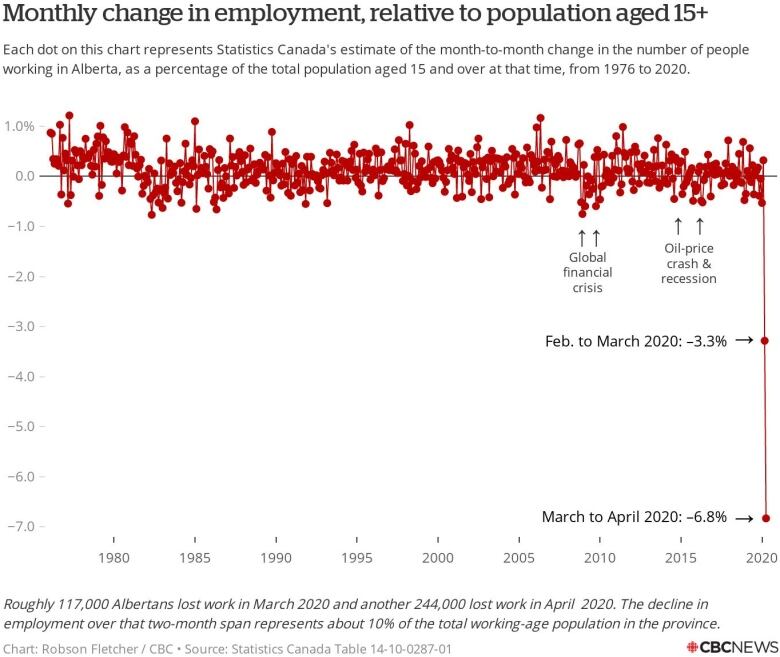Another quarter-million Albertans lost work in April as COVID-19 shutdown grips province
Employment rate for young women cut nearly in half as pandemic hits service sector especially hard

Nearly a quarter-million more Albertans lost work in Aprilas the economic shutdown due to COVID-19 continued, with young workers particularly young women being disproportionately affected.
"That's, by far, the hardest hit group," said University of Calgary economist Trevor Tombe.
"If we look at the sectors that are affected by social distancing, it's the kind of sectors where there's usually close physical proximity so retail, restaurants, accommodation. These are also sectors where there's a lot of employment of part-time workers, and young workers, in particular."
There were 1.969 million Albertans working in mid-April, according to new estimates released Fridayfrom Statistics Canada. That's down 244,000 from mid-March, when social-distancing measures had only just begun.
- From last month: COVID-19 obliterates 117,000 Albertans' jobs, hitting young, female service workers hardest
Combined with the roughly 117,000 people who lost work in March, the province has now seen a decline in employment equal to about 10 per cent of its total, working-age population in the span of two months.
That's by far the largest and fastest decline the province has seensince Statistics Canada's modern employment records began in 1976.

The new numbers further reveal the extent of the economic shutdown across Canada, as well.
Nationally, there were nearly twomillion fewer Canadians workingin April, compared with March. That's on top of the roughly one million people who lost work in March, compared to February.
The global pandemic has had a more pronounced effect on some types of employment, particularly service-industry workers, who tend to be younger.
Employment declines and age
Over the past two months, the employment rate that is, the percentage of people workingamong Albertans under the age of 25 has fallen by nearly 20 percentage points.
Young women in the province saw their employment rate nearly cut in half, falling from55.9 per cent in Februaryto just30.3 per cent in April.
This trend was evident in March, as many service-industry employers were among the first to shut down in the wake of COVID-19.
Hope Sheridan, 25,worked as a recruiter with GoodLife Fitness in Calgary until the gym closed down in mid-March and she was laid off on a temporary basis.
She said her employer hopes to reopen as soon as possible but it's still not clear exactly when they will be allowed to resume operations and, as a young mother, the uncertainty has been difficult.
"It's been extremely stressful," she said.
"There are no answers on whether we're coming back anytime soon."
And while younger female workers were hit hard again in April, Tombe said the effects of the pandemic expanded to other, more male-dominated sectors, as well.
"What we saw in April is, as the economic contraction proceeded, losses in the construction sector and in manufacturing really closed that gender gap quite a bit," he said.
The overall unemployment rate in Alberta jumped 4.7 percentage points from March, rising to13.4 per cent in April.
But Tombe says that figure masks the extent of the job losses, given how many people are not looking for work amid the deliberate shutdown of the economy, and are not included in that count.
When looking at the total"potential" labour force, he said, 32 per cent of Albertans who could be working are not.
Working fewer hours
Another unusual aspect to this economic shutdown is the number of people who are still employed but working fewer hours.
"There are a large number of individuals who didn't actually lose their job but have basically lost all of their hours worked," Tombe said.
About 330,000 people in Alberta recorded zero hours worked in April, he said.
Overall, the number of hours worked in province was down 24.8 per cent compared with February.
The number of hours worked was down even more sharply in other provinces, particularly Quebec.
Tombe noted Alberta was already in an economic slump, even before the pandemic arrived.
"In Alberta's case, the downturn due to the virus is following many months of disappointing economic performance and, indeed, employment losses even prior to February," he said.
"We were potentially entering a second recession even before the virus hit in Alberta, so it's a particularly challenging time for this province."
Exchange in legislature
The province's employment numbers were the subject of an exchange between Alberta NDP Leader Rachel Notley and Premier Jason Kenney in a rare Friday question period at the Alberta legislature.
Notley called on Kenney to extend provincial measures like eviction protections and utility bill deferrals beyond the end of June.
Kenney said his government has already provided $15 billion in relief for Alberta workers and businesses, including emergency isolation payments and a break on WCB premiums. He didn't rule out the possibility of more provincial relief.
"We don't know exactly what the next months hold in store for us," Kenney said. "We'll have to assess what more we do as events unfold."
Notley accused Kenney of not doing enough to help unemployed Albertans who will be facing economic fallout from the pandemic for months.
She also questioned the accuracy of Kenney's claim the province has spent $15 billion on COVID-related relief programs.
"Always doing the bare minimum, putting working people last and waiting for Ottawa to step in," Notley told reporters afterwards.
"While other governments are offering real relief for people, Albertans are getting deferrals and more debt."
With files from Helen Pike and Michelle Bellefontaine












_(720p).jpg)


 OFFICIAL HD MUSIC VIDEO.jpg)
.jpg)



























































































